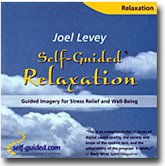Relaxation Technique for Anxiety
This relaxation technique for anxiety can be particularly helpful for you because the major cause of stress for most people arises from self-generated anxiety and worries. Because the body responds equally to mental images as to sensory ones, learning to monitor and sort through our thoughts can be a major step to finding greater balance.
A Story That Doesn't Need to Happen
Here's a relaxation technique for anxiety that comes from a tribe in Africa:
From an early age, children there were trained to be mindful of their thinking. If a person became aware of a foreboding thought like, "Oh no, what if there is a lion hiding behind that tree waiting to eat me?" they learned first to recognize and then release the thought by saying to themselves, "This is a story that doesn't need to happen!"
You can use this relaxation technique for anxiety often. For example, you may be chopping vegetables with a sharp knife and the thought pops up, "I'd better be careful or I'll cut myself." Or you're in a rush driving on the freeway and the image of getting pulled over by the state patrol jumps to mind.
The key to this relaxation technique for anxiety is to first notice your thoughts and then, if they are harmful or unproductive, to say to yourself, "This is a story that doesn't need to happen." This technique is not about getting rid of negative thoughts or about the power of positive thinking.
If a stress inducing "doom and gloom" kind of thought comes to mind, you acknowledge it, you don't try to get rid of it, to hold on to it, or even analyze it. You simply honor it and let it go.
Stories We Want to Happen
Another aspect of this relaxation technique for anxiety is recognizing that some of those stories that pop into our minds are ones we'd like to see happen. In response to a desirable thought like, "Maybe there is a watering hole over there," or "I hope the baby I am carrying will be healthy and a leader for the people," the members of the African tribe would add to themselves, "And this is a healing story!" In your life you might bless or energize thoughts such as, "I know I'll do a great job on that presentation," or "This meal is going to be delicious," or "This lump is probably benign," by thinking or saying, "Yes, this is a healing story."
In our work with leaders and teams, we often teach this relaxation technique for anxiety as a way of strengthening mindfulness of our unconscious, and often self-sabotaging, inner dialogue. Many people have found it very simple and useful.
Applied Self-Awareness
For example, while out on his morning job, the service manager for a medical instrument division we worked with in Australia, noticed a worrisome train of thoughts racing through his mind, "Whoa!" he said to himself, "This is definitely a story that doesn't need to happen!" Immediately he felt his pulse rate slow down, his tension level drop, and his mind come into a more clear, focused, and balanced state.
"It was amazing," he said to us over breakfast, "to see how immediate the effects of this applied self-awareness really are. I recognized that the mental scenario I was running was actually running me. The worries had a life of their own, and they were catapulting me in a direction that I would not choose to go.
It's scary how much physical and mental stress I can create for myself through my own imagination. I would guess that most of the time I'm not aware of what I'm thinking, and that this is really the source of a lot of my stress and tension. In this case, instead of dwelling on the problem like I tend to do out of habit, my heightened self-awareness enabled me to think more creatively about the situation.
When I got back from my walk, I made a few calls and then phoned the client who had a problem with our system. We worked out a solution that was really a "win-win" for their company and for ours. Over the long run, this will only increase their confidence in our ability to deliver and will increase our advantage over our competitors.
Seeing how immediate of an advantage I could gain by recognizing and sorting out my thoughts is really a boost for my self-confidence and likely for my effectiveness on the job as well!"
Breaking the Cycle
Recognizing anxious thoughts will help you smile to yourself and get playfully creative. For example, if you notice thoughts like, "I'll never get this done," "I'll mess this up," "They'll think I'm incompetent," or "My presentation will be a bomb," it may be helpful to smile to yourself and say, "This is a story that doesn't need to happen." And if you notice thoughts like, "My client will love this design," or "People are really going to love this idea!" anchor it by affirming, "And this is a healing story!"
[Adapted from the book "Living in Balance" by Joel Levey
and Michelle Levey]
